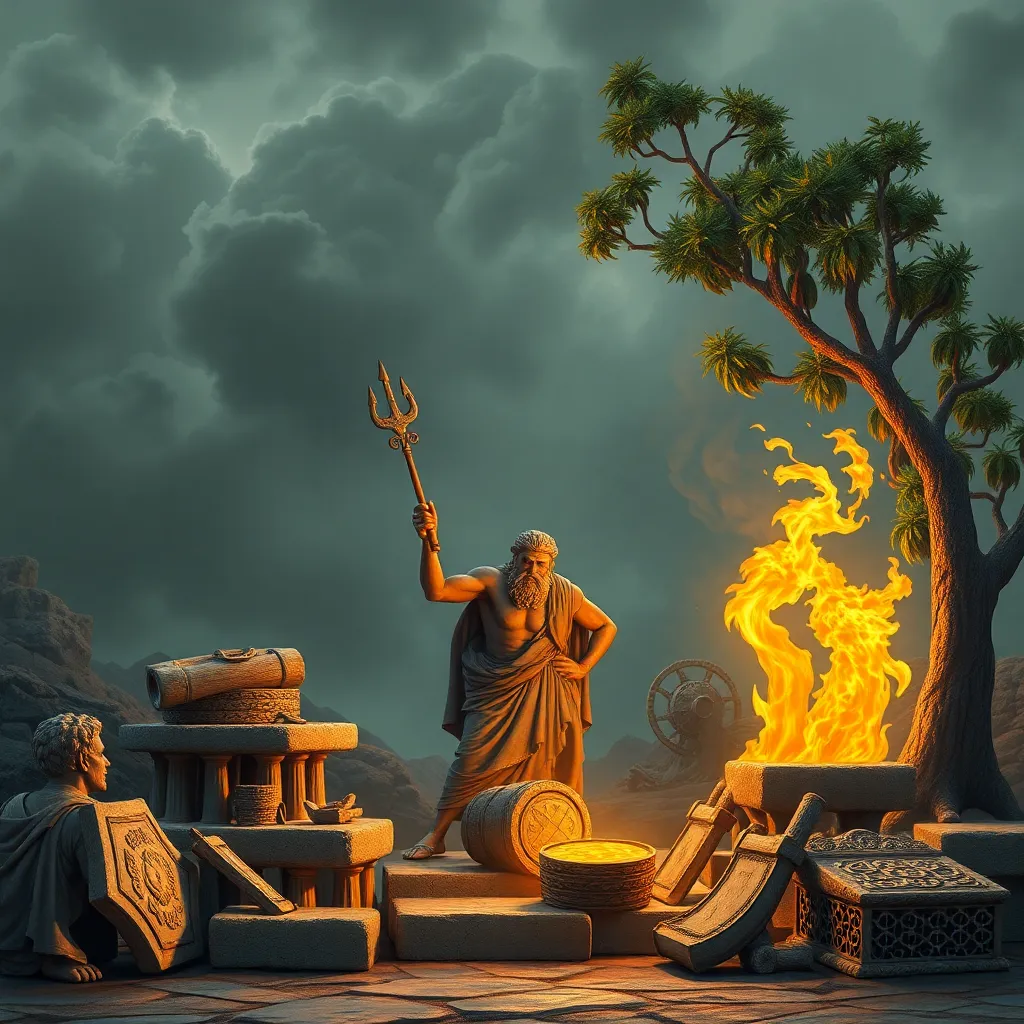Hephaestus and the Nature of Work in Ancient Greece
I. Introduction
Hephaestus, the god of fire and craftsmanship, occupies a unique position in Greek mythology. Recognized for his extraordinary skills in metalworking and artistry, Hephaestus embodies the values and complexities of labor in ancient Greek culture. The significance of work was paramount in this society, as it not only defined personal identity but also contributed to the community’s survival and prosperity. This article aims to explore Hephaestus’s role as a symbol of labor and craftsmanship, as well as the broader implications of work in ancient Greece.
II. Hephaestus: The God of Fire and Craftsmanship
Hephaestus, often referred to as Vulcan in Roman mythology, is the son of Zeus and Hera, though some myths suggest he was born solely from Hera. His origins are marked by peculiarities; he was born weak and deformed, leading to his rejection by both parents. This narrative sets the stage for Hephaestus’s complex identity as a craftsman and symbolizes the idea that true worth lies in one’s skills rather than physical appearance.
The symbolism of fire plays a crucial role in Hephaestus’s identity. Fire represents transformation and creation, elements central to metallurgy and craftsmanship. Hephaestus is often depicted with his forge, surrounded by tools and materials, highlighting his mastery over fire and metal. In the pantheon of Greek gods, Hephaestus serves as a crucial figure who bridges the divine and the mortal through his creations, which include the legendary weapons of gods and the intricate artifacts of mortals.
III. The Nature of Work in Ancient Greece
In ancient Greek society, work encompassed a wide range of activities essential for survival and community well-being. It went beyond mere labor; it was tied to social status and personal fulfillment. The Greeks distinguished between various types of work:
- Physical Labor: Often associated with the lower classes, physical work was essential but viewed with some disdain by the aristocracy.
- Intellectual Pursuits: Activities such as philosophy, politics, and education were highly esteemed, particularly among the elite.
Craftsmanship, however, held a unique place in this hierarchy. It was respected for its skill and artistry. Artisans were valued, and their work was seen as a necessary contribution to society’s function and beauty.
IV. Hephaestus as a Model of Labor
Myths about Hephaestus illustrate his unwavering dedication to work. Despite being cast out and experiencing rejection, he immersed himself in his craft, producing magnificent works. Notable myths include:
- The creation of the armor of Achilles, a symbol of heroism and protection.
- The construction of the automatons, mechanical beings that aided in his forge.
- The crafting of Pandora, the first woman, as a gift to humanity, which blended beauty and skill.
In comparison to other gods, such as Apollo, who embodied the intellectual and artistic pursuits, Hephaestus represented the nobility of labor. His dedication portrays work as a dignified and integral aspect of existence, elevating craftsmanship to a divine level.
V. The Role of Artisans and Craftsmen
Artisans held a vital position in ancient Greek society. While they were not always part of the elite, their skills were indispensable. The status of artisans varied, with some achieving considerable recognition, particularly those who produced exceptional works. Key points include:
- Artisans often operated in workshops, contributing to local economies.
- Their craftsmanship influenced cultural practices, from pottery to sculpture.
- Hephaestus served as a patron, representing the ideal craftsman, inspiring artisans to hone their skills.
The impact of craftsmanship extended beyond the economy; it shaped the cultural and artistic heritage of ancient Greece, evident in the exquisite artifacts that have survived through the ages.
VI. Work and Gender in Ancient Greece
Gender roles in ancient Greece significantly influenced perceptions of work. Men typically engaged in public life and intellectual pursuits, while women were often relegated to domestic responsibilities. However, Hephaestus’s relationships with female figures illustrate the intersection of work and gender:
- Aphrodite: Hephaestus’s marriage to the goddess of love highlights the contrast between labor and beauty.
- Pandora: As the first woman, her creation from Hephaestus represents the complex dynamics of gender and labor in society.
These interactions reflect societal expectations and the roles assigned to genders, showcasing how work was intertwined with identity and status.
VII. Philosophical Perspectives on Work
Ancient Greek philosophers offered varied views on labor, often debating its value and purpose. Key philosophers include:
- Aristotle: He viewed work as essential to achieving eudaimonia, or human flourishing, positing that productive work contributes to a well-lived life.
- Plato: He distinguished between different forms of work, emphasizing the importance of intellectual labor over manual work.
Hephaestus embodies philosophical ideals related to labor, demonstrating that dedication and skill can lead to personal fulfillment and societal contributions. His existence reminds us that all forms of work play a role in the tapestry of human life.
VIII. Conclusion
Hephaestus stands as a powerful symbol of craftsmanship and hard work in ancient Greek culture. His significance transcends mythology, offering insights into the value placed on labor and the role of artisans in society. The legacy of Hephaestus endures, influencing contemporary views on work and craftsmanship. As we reflect on his story, we recognize the importance of dedication, skill, and the nobility of labor, aspects that continue to resonate in today’s world.




